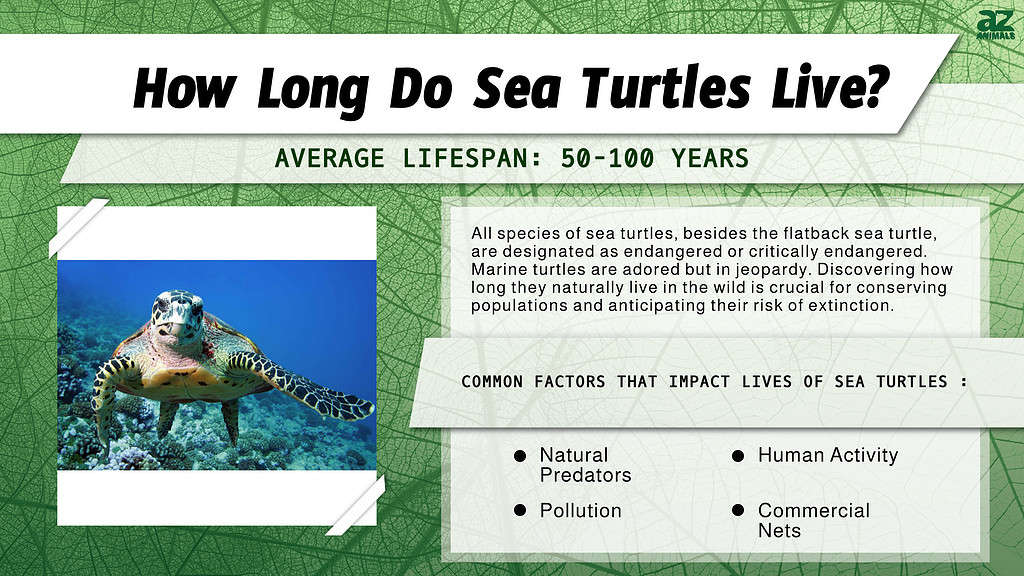
A green turtle swimming in the sea. Turtles use cloacal respiration in addition to respiration with their lungs.
©iStock.com/Greg Sullavan
Up until recently, limited research has been available on the lifespan of Sea Turtles. This is because migratory marine species are difficult to track, making wild animal lifetime studies problematic. Marine turtles, for example, may survive generations of researchers.
For the first time, scientists have identified a way to utilize DNA to accurately estimate the lifespan of this species. Find out how long sea turtles are believed to live in the following paragraphs!
How Long Do Sea Turtles Live?

A new study has determined the lifespans of five marine turtle species, the Leatherback, Loggerhead, Olive Ridley, Hawksbill, and Flatback.
©zulkamalober/Shutterstock.com

Until recently, green sea turtles were the only species whose genome sequence was made public. However, using innovative environmental management research, a new study has determined the lifespans of five marine turtle species.
| Sea Turtle Species | Average Lifespan |
| Leatherback sea turtle | 90.4 years |
| Loggerhead sea turtle | 62.8 years |
| Olive Ridley sea turtle | 54.3 years |
| Hawksbill sea turtle | 53.2 years |
| Flatback sea turtle | 50.4 years |
Sea turtle lifespan can also be predicted by their weight, according to the researchers. In general, heavier, and longer-shelled species live longer.
Therefore, it is not surprising that the Leatherback sea turtle is not only the largest living sea turtle species but also has the longest expected lifespan.
Lifespan Prediction Limitations
This recent research represents a generalization about the entire species. It’s impossible to forecast life expectancy because of the effects of the environment and population variation. As a result, it is not possible to estimate individual lifespans using genetics, but the lifespans of an entire species.
Common Causes of Death For Sea Turtles

Sea Turtles are dying from natural predators, human activity, pollution, commercial nets. hunting. and climate change.
©Ezpete – Public Domain
Natural Predators
Sea turtles have several natural predators. Tiger sharks and killer whales consume adult sea turtles. Dogs, seabirds, and raccoons consume sea turtle eggs and hatchlings.
Human Activity
Sea turtles also face various risks from human activity. Disturbances like noise can scare sea turtles away from their nesting places. Artificial light can cause problems since hatchlings will crawl toward artificial light sources as they would toward daylight. The glare often confuses hatchlings, leading them astray.
Pollution
In rare circumstances, sea turtles might perish from ingesting litter mistaken for food or getting caught in debris.
Commercial Nets
The most significant problem to the survival of sea turtles is the possibility of drowning in big commercial nets that are used to collect shrimp. Sea turtles cannot live underwater for a long time without surfacing.
Hunting
Other risks to sea turtles include illegal hunting for flesh and shells and illicit egg gathering.
Climate Change
Sea levels are rising due to climate change, and storms are wreaking havoc on their seaside homes. Sea turtles could be exposed to new predators and coral reefs could be destroyed because of changing currents caused by warming oceans.
Are Sea Turtles Dying Off?

All species of sea turtles aside from the flatback are currently endangered.
©Magdalena Paluchowska/Shutterstock.com
All species of sea turtles, besides the flatback sea turtle, are designated as endangered or critically endangered. Marine turtles are adored but in jeopardy. Discovering how long they naturally live in the wild is crucial for conserving populations and anticipating their risk of extinction.
How You Can Help

You can help protect our sea turtles by not littering and also by leaving sea turtle eggs alone on the beach.
Protecting marine turtles is as easy as following a few simple guidelines:
- Make sure you don’t litter the beach.
- Avoid shining artificial light on beaches at night where sea turtles lay their eggs.
- Don’t use eyeglass frames or combs manufactured from sea turtle shells. There is unlawful.
- Continue to educate yourself and others about the plight of endangered sea turtles.
The Takeaway…

Determining the lifespan of our sea turtles aids us in predicting extinction risk.
©Isabelle Kuehn/Shutterstock.com
Every sea turtle species is threatened, endangered, or extremely endangered. Poaching, fishing gear entanglement, and even climate change threaten their populations severely. To conserve and protect an animal species, we need to know how long it will take for populations to develop and recover, and how long it will take for animals to reach reproductive age.
In the case of fragile species like sea turtles, estimating lifespans without knowing lifespan forecasts might be tricky. However, this recent discovery provides a way to anticipate other species’ lifespans without catching and releasing or following a single individual. By predicting extinction risk and population increase, we can start planning effective conservation strategies for our beloved marine reptiles.
The photo featured at the top of this post is © Achimdiver/Shutterstock.com
Thank you for reading! Have some feedback for us? Contact the AZ Animals editorial team.







